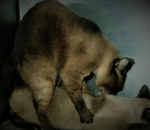Lumpy Skin Disease is caused by the Lumpy Skin Disease Virus (LSDV) which belongs to the genus capripoxvirus and family poxviridae. Lumpy skin disease (LSD) causes disease only in cattle & buffalo (but other species such as camels and giraffes are sensitive).
LSD causes heavy economical loss in the cattle industry. About 40-60% direct production loss is seen in affected herds. Indirect losses are faced in the form of eradication and control measures and export restrictions.
Transmission
This disease is transferred from diseased animals to healthy animals through blood-feeding insects (mosquitos, biting flies, and male ticks). Direct contact between animals is considered to play a very minor role in transmission.
Morbidity varies between 5-25% and even 80-9% during outbreaks while mortality rate is less than 10%.
Signs & Symptoms of LSD
- High Fever (may exceed 41 degree celsius)
- Eye & nasal discharge
- Superficial enlarged lymph nodes
- Anorexia, depression and emaciation can be visualized
- Skin lesions or cutaneous nodules (that involve skin & subcutaneous tissue) of 1-5 cm in diameter develop on limbs, neck, head, and other body surface. Nodules are raised, round, painful, and firm.
- Lesions (erosions, ulcers) may develop in the mucous memebranes of the mouth, GIT, and in the trachea and lungs.
- Limbs & ventral body parts are swollen and oedematous. Animal shows signs of lamness.
- Abortion in pregnant cows may be seen and they may remain in anoestrus for several months
- Bulls may show permanent or temporary infertility.
- Severe infection may lead to secondary pneumonia, mastitis and necrotic skin plugs.


Differential Diagnosis
- Bovine herpes mammillitis (also known as pseudo lumpy skin disease)
- Demodicosis
- Onchocerosis
- Photosensitization
- Allergic reactions or Insect bites
- Infection of hypoderma bovis
- Besnoitiosis
- Rinderpest
- Bovine papular stomatitis
- Pseudocowpox
Laboratory Diagnosis
- Identification of virus can be done through Polymerase chain reaction (PCR). For PCR detection of LSDV, nasal secretions, blood, saliva, and skin nodules are suitable samples.
- Virus neutralization test & ELISA kit, indirect fluorescent antibody test and immunoblotting are used to detect antibodies against capripoxviruses.
- Electron microscopy is also used to distinguish capripoxviruses from the parapoxviruses.
Lumpy Skin Disease Treatment
There is no specific treatment for Lumpy Skin Disease. Only supportive therapy should be adopted. Antibiotics should be used to avoid secondary bacterial infections. Wound dressing is essential to avoid myiasis, secondary infections, and reduce fly strike.
Prevention & Control of LSD
Control depends upon restriction of movements of infected animals, contaminated hides and other animal products. Following steps can help to eradicate and control the disease.
- Depopulation of affected animals,
- Quarantine measures
- Movement controls of affected animals
- Cleaning and disinfection of infected premises
- Rapid mass vaccination programs
- Proper disposal of dead animals that died from LSD (incineration)
- Insect or Vector control (its effectiveness is still unclear)
Live attenuated vaccines are available to be used as a preventive measure. Killed vaccines may also be available in some areas.

Lumpy Skin Disease in Human
No evidence supports the presence of LSD in human population. LSDV is not zoonotic.

